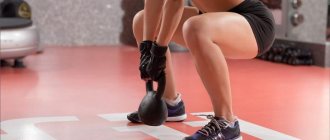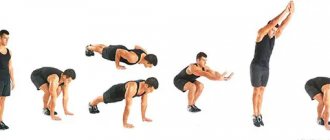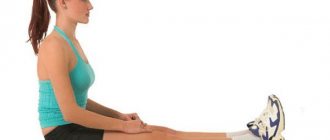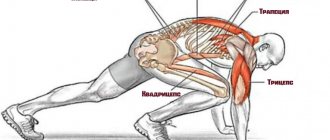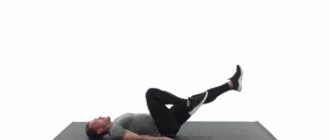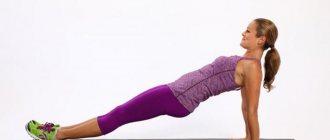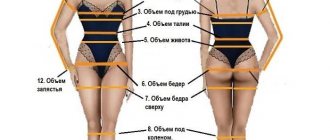What is a cool down
This is a term used to describe gentle exercises performed at the end of a workout to allow the body to gradually transition from an excited state to a calm or near-calm state.
As a cool-down, you can use slow running, which gradually turns into walking, as well as stretching.
Cooling down helps remove accumulated lactic acid, which can cause cramping and stiffness. Cooling down allows you to gradually lower your heart rate, bringing your heart back to normal. However, contrary to popular belief, cooling down does not reduce long-term muscle soreness.
After exercise, peripheral veins, especially those within the muscles, are dilated to maintain adequate blood supply to the muscles. Skeletal muscle acts as a pump, helping to return blood to the heart and keep it pumping.
A sudden stop in physical activity can cause more of the blood to remain in the veins of the muscles, thus forcing the heart to increase its rate and workload to maintain blood flow to the organs.
Calming exercises or cool down
Cooling down (or Calming exercises) allows you to prevent this condition, since during its implementation the tone of the intramuscular veins returns to normal, and the heart will not experience overload at the end of the workout.
The duration of a cool-down in bodybuilding is on average 5-10 minutes.
This is a series of gentle aerobic exercises used as stretches to complete the workout. These exercises help gradually reduce the load on the heart.
Final stage: cool down
Here it is necessary to say a few words about cardio exercises and the cardiovascular system. Since work on cardio equipment can take place both at the beginning of a workout and at the end, it can be performed accordingly both as a warm-up and as a cool-down.
Cardio training is a type of stress on the body in which the emphasis is on the respiratory system, heart and blood vessels.
Training the heart and blood vessels prepares the body for future, higher loads that you will have to experience during training. This type of workout will help warm up your muscles and joints before lifting weights, and can also be used as a finishing step at the end. There is no need for haste here; increase the load gradually, methodically increasing the pace, or, if this is a hitch, also gradually reducing it. As for training in the gym, as a rule, the load on the cardiovascular system is exerted using a treadmill, exercise bike, orbitrack, and possibly with the help of an invention such as a stair simulator or the most common jump rope, if you train in the gym , where such simulators are not available.
As for cardio equipment specifically, before strength training it is necessary to gradually increase the pace and perform light work with minimal load for 5-10 minutes until the heart rate (HR) reaches approximately 110-130 beats per minute (almost all modern cardio equipment have built-in heart rate monitor). As for the cool-down, starting with jogging or even fast walking, it is necessary in the same way, within 5-10 minutes, to gradually reduce the pace to a complete stop. This will help bring your heart rate back to normal, prevent muscle pain and relieve tension.
After completing the cool-down, in order to catch your breath and come to your senses, you can sit down, close your eyes and take a few deep breaths in and out to relax. While inhaling, you will need to think about the last training session, how you carried it out, what you were able to do and what you were not able to do. You can praise yourself for successfully completing the task, or scold yourself if you messed up somewhere. By exhaling, you release stress, tension and fatigue. Now you can open your eyes and go change clothes with a feeling of accomplishment.
Simple cool-down exercises
Let's look at 5 simple warm-up exercises that will help warm up your body before training:
Stretch the neck muscles to the sides
Place one hand on the top of your head and extend the other along your body. Tilt your head to the side and make a slight effort with your hand on the top of your head. Don't pull your shoulders up. Hold the tilt at the maximum point for a few seconds. Repeat with an incline to the other side.
Stretch the neck muscles to the sides
Delt stretching
Stand straight with your feet shoulder-width apart. Extend your arm in front of you and clasp your forearm at the elbow. Press your hand to your body and hold for a few seconds at the extreme point. Do the exercise for both hands.
Delt stretching
Standing triceps stretch
Stand up straight, bend one arm at the elbow and place it behind your head. With your other hand, grab the elbow of your bent arm and apply a little pressure. Do not make sudden movements; there should be a feeling of slight stretching. Stay at the extreme point for 10-20 seconds. Switch hands.
Standing triceps stretch
Dynamic stretching of the back muscles
Stand straight with your feet shoulder-width apart. Swing both arms at the same time in front of you. Increase the amplitude each time until your arms rise above your head. Repeat 10 times. Do not jerk at the extreme point.
Dynamic stretching of the back muscles
Latissimus dorsi stretch with emphasis on the wall
Stand facing a wall at a wide stride distance. Bend your elbow and rest your forearm on the wall above your head. Slowly tilt your torso toward your arm, stretching your back muscles.
Latissimus dorsi stretch with emphasis on the wall
Swing your leg forward and backward
Stand next to a support, a chair or a wall will do, hold on to it with your hand. Swing one arm forward, keeping your leg straight, then swing back. Raising your leg, your back remains straight. Return to the starting position. Do 10-20 swings with each leg.
Swing your leg forward and backward
Quadriceps stretch with roller
Lie face down on the floor. Support your body weight on your palms or forearms. Place the bolster under your right thigh. Lift your foot off the floor. Relax your leg as much as possible. Roll forward on the roller. Support your body weight on your arms. Stay in this position for 10-30 seconds. Switch legs.
Quadriceps stretch lying face down on the floor using a bolster
Hamstring stretch on a roller
Sit on the floor and straighten your legs. Place the bolster under the upper thigh of your right leg. Leaning on your hands, lift your hips off the floor and transfer your body weight to the leg with the roller. Relax the thigh and shin of your working leg. Roll your foot along the roller from the top of your thigh to your knee. Switch legs.
Hamstring stretch on a roller
This set of exercises will not take much time and will perfectly prepare the body for training. These 5 exercises can be included after your workout.
Cool-down exercises after running and Nordic walking
To restore your breathing after a run or a fast walk, we recommend not stopping, but walking a little more at a calm pace. Then start doing the exercises:
- We stand up straight and put one leg forward. The distance between the feet is 50–60 cm. Both heels should be pressed to the ground. We bend towards the exposed leg and stretch our hands towards the sneaker. We maintain time in this position and repeat the tilt to the other leg.
- We select a stable support, for example, a lamp post. We lower our palms onto it and take a couple of steps back. Press your feet completely to the ground. We stand in an inclined position and stretch the calf muscles.
- We lower ourselves into a right-sided deep lunge. We tilt our body forward a little and grab our shin with our right hand. We stay in position. When doing this, do not round your back. Repeat with the left leg.
- We stand in a longitudinal split (it is not necessary to completely fall to the ground, as best you can). We stretch from this position. If it works, keep your back vertical and your palms on your waist.
- We get into a cross split (again, as best you can). Smoothly bend over to one leg and place your hands on your shins. We hold our position. We try not to bend our knees. Repeat on the other side.
- We lower ourselves into a side lunge. We perform slow rolls to the right and left. We move the pelvis parallel to the floor.
- We stand up straight, lean forward and try to press our palms to the ground. Let's stretch in this position.
The duration of each exercise is 15–20 seconds. After the cool-down, massage the muscles of the legs and thighs using circular movements with the palms.
Cool down with an app
We downloaded a special application and are ready to tell you about the importance of warm-up and cool-down in this review. Any experienced athlete knows for sure that you cannot immediately start working on your body without preparation. Likewise, after active exercise, you should not leave your body in a maximally tense state.
The Bodymaster team tested a simple, free and effective Exercises app for warming up and cooling down , which you can do.
If you are new to sports, at first you will be confused about the concepts of “warm-up”, “cool-down” and “stretching”. Remember that these are different types of exercises that need to be performed during a certain period of training.
- Warm-up is a set of exercises to warm up muscles and joints. You prepare your body for strength loads, improve concentration and perception. On average, warming up before exercise should take about 10-15 minutes.
- Cool down is a restorative exercise that helps to even out muscle tone, regulate pulse, blood pressure and body temperature. For this type of exercise, in particular, exercises with a foam roller are suitable (link to review). Experts recommend taking about 5-10 minutes to cool down.
- Stretching is also recommended after training. This complex helps trained muscles return to their original size to build new mass.
You can watch a more detailed review in our video:
Warm-up and stretching: why to do it
Excessive stress while running without warming up can lead to sprains, sprains, pinched nerves and other injuries. Ligaments, muscles and joints are in a vulnerable state if they have not received sufficient warming.
A cool-down is also important, as it restores the body after playing sports. Always warm up before running or doing cardio, and stretch afterwards to forget about injuries and train much more effectively.
See also:
- Top 60 exercises for cardio training at home
- Intense 500 kcal fat burning workout
Why you need to warm up and cool down:
- To improve blood circulation and oxygen supply to muscles to make the body more resilient.
- To increase reaction speed due to improved neuromuscular connections.
- For the elasticity of ligaments and joints, which reduces the risk of injury and improves athletic performance.
- To increase concentration and perception, increase motivation for training.
- For body flexibility and prevention of soreness.
- To restore breathing and normalize all body processes.
10 rules for warming up and cooling down:
- Start doing warm-up exercises at a slow pace to allow your body to adapt to the load.
- The joint warm-up before running should begin with the neck and end with the ankle, gradually involving all joints and muscle groups.
- You should not warm up for more than 15 minutes, otherwise you will be tired before training.
- Warm-up in the morning should last longer than in the evening, as the body needs to wake up.
- Start training immediately after warming up: after just 5 minutes of inactivity, the body will be in the same state as before the warm-up, and you will have to warm up again.
- If in the warm-up more attention is paid to warming up the joints, then in the cool-down - stretching the muscles.
- To cool down after running, do breathing exercises and then move on to stretching.
- If the workout was very intense, then you can start the cool-down by walking in place for 1-2 minutes to restore breathing.
- The basis of the post-workout cool-down should be static muscle stretching exercises.
- Stretch after running without sudden movements, at a slow pace, paying attention to each muscle group.
Why do you need a cool down and warm up?
- By warming up before a workout, you don't just warm up your muscles, preparing them for stress. Qualitative changes occur in almost all vital systems of the body:
- The heart rate increases, blood flow increases, and the muscles are better supplied with nutrients.
- Blood pressure increases, also providing rich blood flow to the muscles.
- Muscles become more resilient. Reduces the risk of injury.
- Due to rapid breathing, ventilation of the lungs increases, the body stores oxygen for future use.
- Due to improved neuromuscular communication, the body requires less energy. Consequently, the central nervous system is less overloaded.
- Body temperature rises to 38.5 - 39 degrees Celsius. Due to this, physiological reactions occur more efficiently. In addition, ligaments and tendons become more flexible and elastic.
- The body produces more joint fluid, increasing the volume of articular cartilage. Because of this, it is easier to bear pressure during training.
- Warming up increases concentration and perception to overcome obstacles. It is easier for an athlete to motivate himself to work with his body, and the positive attitude toward results increases.
Experts also recommend following simple but essential warm-up rules:
- Body temperature must be increased gradually, without sudden jumps.
- When warming up, take into account the weather, time of day, age and experience of the athlete.
- Warm-up duration is from 10 to 15 minutes.
- Between warm-up and training, no more than 5 minutes should pass, since after this the saturation of the muscles with blood begins to decrease.
Why do you need a cool down after training?
Cooling down restores the body, exhausted by intense exercise. So, after a quick climb from the first to the fifth floor, you are unlikely to be able to do any hard work: you need to catch your breath and relax your muscles.
The same principle applies to sports training. Without effective rest, it will be much more difficult for you to start new exercises, including exercise machines.
Effects of a quality cool down:
- Muscle tension decreases;
- Pulse, body temperature, blood pressure are equalized;
- Restores the central nervous system
- Lactic acid is removed from the body, which causes you to feel a burning sensation in your muscles.
As with the warm-up, it is important to follow the rules during the cool-down:
- Cool-down exercises should not last more than 10 minutes;
- Monitor your pulse - it should not rise above 120 beats per minute.
For a cool-down, an exercise bike, treadmill, or foam roller are ideal for rolling tense muscles. After the cool-down, you can spend some time in the bathhouse or sauna, and also have a massage session.
A set of stretching exercises
Exercise No. 1 for stretching the neck and trapezius
Performing the exercise: Lower your head down, press your chin to your chest and freeze in this position for a couple of seconds. Then we move our head back and freeze, performing static stretching of the neck muscles. Similar to the first two, we rotate the head to the right and left
Shoulder stretch exercise #2
Press your elbow to your shoulder
Performing the exercise: In a standing position, stretch one arm across the chest. We place the other hand slightly above the right elbow and gently pull the hand towards ourselves, paralleling it to the chest. Above the elbow you can grasp it with both the palm and the back of the wrist. At the point of static tension, the inside of the right elbow is pressed against the left shoulder. We pulled one delta, change hands and pull the other. To strengthen the exercise, you can bend your arm at the elbow joint, moving your wrist behind your back.
Exercise #3 for shoulder stretching
Pull your elbow behind your back
Performing the exercise: With your left hand, take the forearm of your right hand and pull it (right hand) to the left and slightly up. At the point when you feel tension in the middle fascicle of the deltoid muscle (in fact, a stretch point), we pause for the required time, after which we change hands.
Exercise No. 4 for stretching the triceps:
Performing the exercise: In a standing position, the arm, bent at the elbow joint, is placed behind the head from behind. We take the other by the elbow of the right hand and pull the right elbow down by the head. At the point where the maximum stretch of the triceps is felt, we freeze and pull the muscle for 30–60 seconds, after which we change hands.
Exercise No. 5 for stretching the biceps:
Retracting your arms behind your back
Performing the exercise: In a standing position, we put our hands behind our backs, clasp them in a lock and move this “lock” back and up.
Exercise No. 6 for chest stretching:
Stretch from the wall
Performing the exercise: stand with your back to the door frame or wall bars, grab the vertical support with your outstretched hand. We turn the body away from the hand and, feeling the maximum stretch of the muscle, freeze for the required time. Then we change hands.
Exercise No. 7 for stretching the back:
Performing the exercise: Kneel down, then sit on your heels and place your straight arms extended forward on the floor. The heels are placed under the buttocks. We pull our arms forward as much as possible, and, feeling the stretching of the wings, continue to stretch our arms for 30–60 seconds.
Exercise No. 7. Can be replaced with the exercise shown in the picture
Exercise No. 8 for stretching the lower back
Tilts with support
Performing the exercise: To perform this exercise, you need to stand in front of a support. For example: a table, or the back of a chair, or a gymnastic goat. Lean your elbows on this object, and trying not to bend your knees, bend as low as possible.
Exercise No. 9 for stretching the abs
Performing the exercise: Lie down on the floor, rest your hands on the floor and raise your shoulders, i.e. We lie with only part of the body up to the waist. We throw our head back and, without changing the position of our body, pull our shoulders and head back and up. Having felt the maximum stretch of the abdominal muscles, we freeze and remain in this position for 30-40 seconds.
Exercise No. 10 for stretching the legs
Performing the exercise: We put one leg forward, the other one back. Bend both legs at the knee joint to approximately 90 degrees. One knee touches the floor, while the second at the stretch point is at the level of the lower back. We change the angle in the knees: instead of 90 degrees in both knees, we increase the bending angle of the back leg, and on the contrary, we reduce the bend of the front leg. We move our back leg back, and vice versa on the front leg, we lie down with our whole body. When we feel tension in the back of the thigh, we freeze. After stretching one leg, we switch legs and stretch the other.
Exercise No. 11 for stretching the legs
Stretch the thigh surface
Performing the exercise: In a standing position, raise your right leg, take it with your right hand, reach it to the buttock and freeze for 30–60 seconds. We do the same stretch with the second leg. If it is difficult to maintain balance, then you can lightly lean your elbows on a wall or any other object with your free hand, or move your hand to the side for ballasting
Exercise No. 12 for stretching the legs
Performing the exercise: In a standing position, we bend over and hug ourselves by the knees, i.e. We take ourselves by the ankles and pull the body towards the legs. Ideally, your knees should be level. Without fanaticism, we stop at the point where the stretching of the legs is felt maximum and freeze for a couple of seconds.
Warm up and cool down. Exercises in the app
The training course in the application follows a familiar and well-developed scheme. On the main screen, all exercises are collected into two complexes:
- Warm Up (set of exercises for warming up)
- Cool down (cool down after exercise)
You set the time during which you will perform the activities. Based on this time, the application will put together a set of exercises for you. In preview mode, you can see what the mobile program has prepared for you, and also put all the exercises in random order.
The training takes place in the format of visual lessons. The model in the video shows the technique, and the voice instructor gives commands to get ready, start, change sides and finish.
Once you've completed the exercises, your workout is marked on the calendar. So you can see on what day and for how many minutes you worked out and how many calories you burned.
All exercises for warming up before training and cooling down after it are collected in a separate list. Here, each exercise is provided with a visual video card.
If you purchased the premium version for 119 rubles, you are given access to individual training. You set the duration of the workout, the frequency and duration of rest, and make yourself a list of exercises.
We also recommend setting up notifications for yourself so that you don’t forget to complete the appropriate exercises.
The application does not contain any detailed and visual reporting; there are no graphs or tables of your workouts. The maximum you can personalize is height and weight data.
However, complex reporting is not particularly needed here. Warm-up and cool-down application. The exercises are purely practical in nature so that your workout brings the most beneficial results.
Exercises to stretch the back muscles
Lat stretch against the wall
In order to stretch the latissimus muscles as much as possible, two points must be observed. Raise your arm above your head to increase the distance between the attachment points. And while performing the exercise, move your pelvis in the opposite direction from the muscle being stretched. As a support, you can use a wall or a squat frame stand.
Performance:
- Stand with either side to the wall (stand).
- Bend your arm at the elbow joint and rest your back (triceps) against the wall.
- From this position, we begin to press with all our weight towards the raised arm, and move the pelvis in the opposite direction.
- As soon as you feel the stretch in your lats, hold this position for 20-30 seconds.
- Repeat the same on the other side.
Tilts to the side
After we have completed the lat exercise, we should stretch the lower back muscles. To do this, it is enough to perform the well-known side bends with a straightened arm.
Performance:
- Stand up straight. Spread your legs wider than your shoulders.
- Place one hand on your side and raise the other above your head.
- From this position, we lean to the side as much as we can.
- At the lowest point, pause for 20-30 seconds.
- Repeat the same on the second side.

